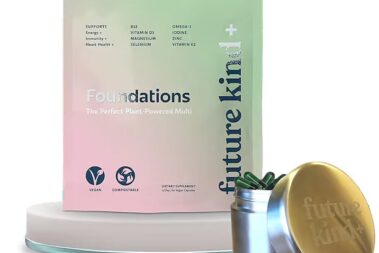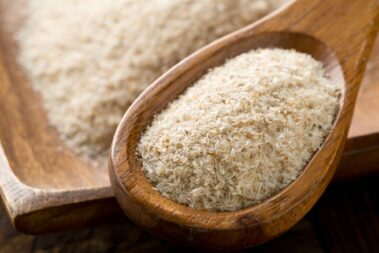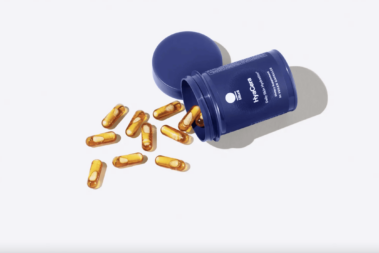Calcium is an important nutrient for growing strong bones, supporting healthy muscles, and regulating normal heart rhythms and nerve function. Adult women and older men must consume calcium at higher rates than the average adult. The same is true for growing teens.
If you follow a plant-based diet then it may seem difficult to get enough calcium. After all, the most celebrated sources of calcium all fall into the dairy category.
But, as it turns out, there are actually a number of excellent sources of calcium in the plant world. Here are 14 whole-food vegan calcium sources you should include in your vegan diet.
Table of Contents
The Best Plant-Based Sources of Calcium
Cow’s milk may be the most celebrated source of calcium, but it is far from the best. Compounds in dairy products reduce the absorption of calcium, meaning you don’t get as much as what the bottle says. And a lot of other aspects of dairy are not great for your health and can actually lead to more bone fractures if consumed too often(1).
Some plant sources of calcium also have low absorption rates. But just as many have higher rates of absorption and most support overall health in ways that dairy products simply do not.
Below are 14 of the most calcium-rich foods you should include in your vegan diet.
NOTE: Our recommended daily intake (RDI) calculations from the section below are based on an RDI of 1,000 milligrams of calcium.
Almond Milk
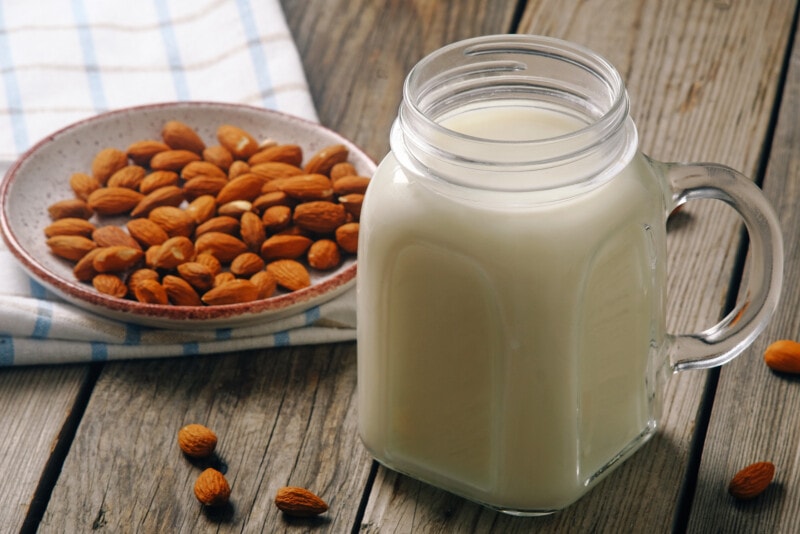
If you’re looking for a plant-based milk replacement, almond milk is a great choice. Not only do most almond milk products contain more calcium than dairy milk, but this calcium is also more readily available for your body to use.
Almonds have a high amount of naturally occurring calcium in them. And the typical carton of almond milk has about 20 to 30% of the RDI for calcium—more than most soy milk and oat milk products. But not all of this calcium comes from the almonds.
Most plant milks are fortified with vitamins and minerals. And calcium is one mineral almost all commercial plant-based milk contains.
Because of this, all fortified vegan milk makes a decent source of dietary calcium. To maximize your liquid calcium intake, opt for soy milk or oat milk if almond milk isn’t your thing.
Fortified Orange Juice

A whole orange is no slouch in the calcium arena. Each contains about 74 mg, or 8% of your RDI, higher than most fruits. But it’s fortified orange juice that really delivers in terms of calcium.
A serving of orange juice fortified with minerals contains, on average, 300mg of calcium, or 30% of your RDI. Fortified orange juice also typically contains vitamin D, an important nutrient to aid in the absorption of calcium. This makes OJ a great drink to include with your morning breakfast.
Tofu
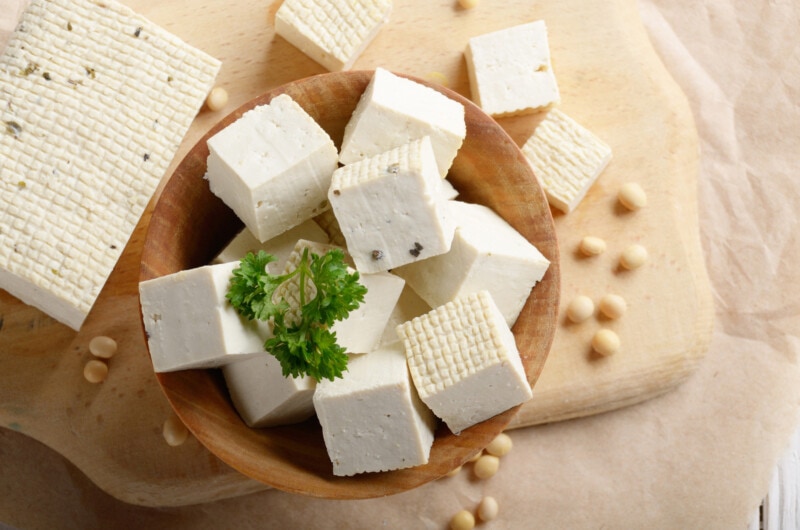
Soy already has high levels of calcium. But tofu, which is typically processed with calcium sulfate, has even more!
A large serving of extra firm tofu (½ cup), contains 10 to 19% of your daily RDI of calcium. Silken tofu, which requires less calcium sulfate for processing, contains about 11% RDI for the same serving size.
Do pay attention to the nutrition label, however, because some types of tofu are not processed with extra calcium. Therefore, they do not contain as much of this bone health-supporting nutrient.
Blackstrap Molasses
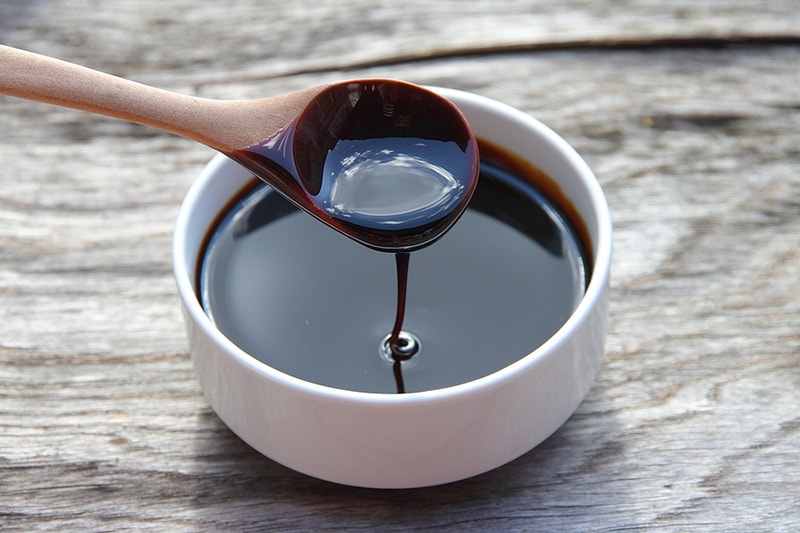
One surprisingly good source of calcium is blackstrap molasses. This product of the sugar cane industry is made by vigorously boiling sugar cane juice and repeatedly extracting crystalized sugar from it. What’s left is a sweet, salty, mineral-rich sludge.
Blackstrap molasses has a whopping 179 milligrams of calcium (18% RDI) per tablespoon. It’s also loaded with iron and other valuable minerals vegans need.
This thick syrup is not nearly as sweet as cane syrup and is fairly bitter and salty. The best way to include it in your diet is by using it in baked goods, sauces, and dressings, and by adding it to your morning smoothie.
Dried Figs
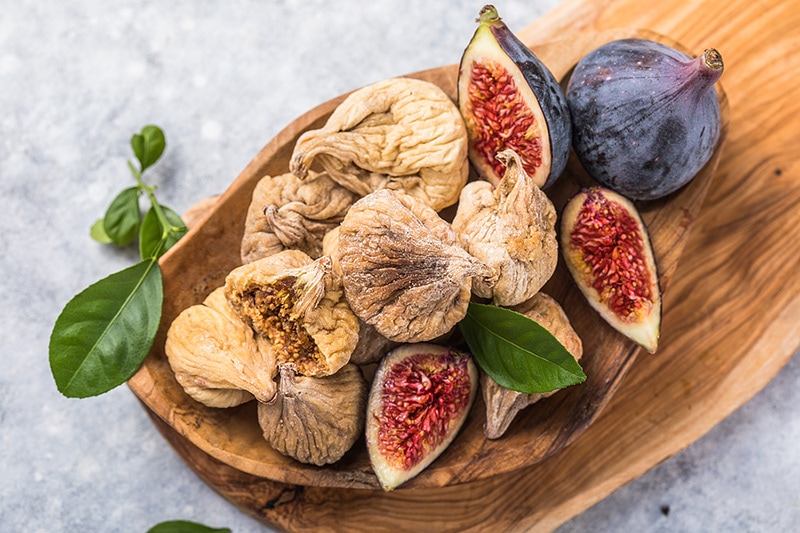
Like many fruits, fresh figs only contain a small amount of calcium. But when you remove the water and shrivel these fruits down, you end up with an excellent source of calcium.
A large serving of dried figs (100g) provides 162 mg of calcium or about 17% of your RDI.
Dried figs can be eaten whole, chopped and added to baked goods, made into jam, or added to raw energy balls. Like other dried fruits, they are also a decent source of iron.
White Beans

Many beans contain calcium in some amount, but white beans have the most. In one cup of cooked white beans, you’ll get about 140mg of calcium (or 14% RDI). Adding white beans to your diet is easy. We’re big fans of adding white beans to our chili, bean dip, and minestrone soup.
All varieties of white beans, including navy beans, cannellini beans, and great northern beans, are high in calcium.
Other types of beans that contain decent amounts of this mineral include:
- Pinto beans – 8% RDI per 1 cup
- Garbanzo beans – 8% RDI per 1 cup
- Kidney beans – 6% RDI per 1 cup
- Black beans – 4% RDI per 1 cup
- Black turtle beans – 4% RDI per 1 cup
Amaranth

Most grains are poor sources of calcium. But some ancient grains are flush in this area, especially amaranth. In fact, this tiny grain contains an impressive amount of calcium.
Per 1 cup of cooked amaranth, you get 116 milligrams of calcium (or 12% RDI). The secret behind amaranth’s high calcium content is that this little grain isn’t actually a grain at all. It’s a seed, and as you’ll see in a bit, many seeds are high in minerals.
One true grain that also contains 12% of your RDI of calcium is teff. This rare, fine grain is similar to amaranth in texture and flavor. Teff is also packed with protein, making it doubly worth hunting down.
Kelp
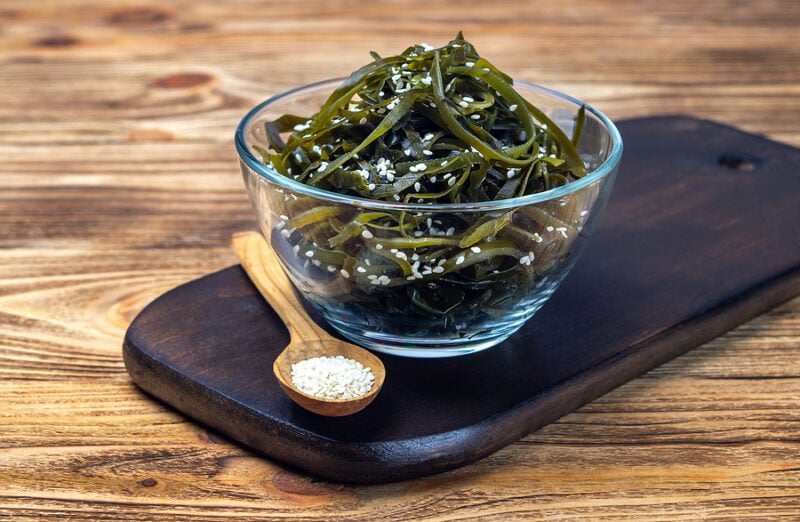
Seaweed and kelp are two calcium-rich products that come to us via the sea. Raw kelp, which is a specific type of seaweed, contains 12% of your RDI of calcium (about 120mg) per cup.
You can include kelp in your diet by adding it to soups, juicing it with vegetables, creating kelp noodles for salads, and using dried kelp as a seasoning. Just don’t go overboard with this calcium source, as seaweed can contain a lot of heavy metals and more iodine than you need.
Breakfast Cereal
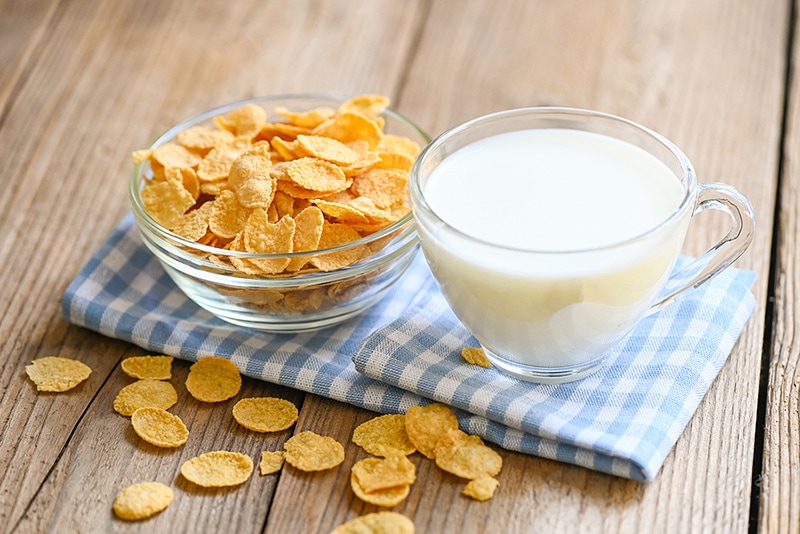
Like vegan milk and orange juice, many breakfast cereals are fortified with minerals. Most of these contain around 11% of your daily calcium requirements (100 to 130mg). They are also a good source of iron and vitamin D.
However, not all sources of vitamin D are vegan-friendly, so be sure to choose a fortified breakfast cereal that is certified vegan.
Edamame

Plain soy, as we mentioned earlier, is a good source of calcium. Edamame is an immature form of fresh soybeans. These make a delicious raw, freeze-dried, or sauteed snack.
One cup of edamame provides about 98 mg of calcium or 10% of your RDI.
Soybeans are also a great source of protein and phytoestrogen. These estrogen-like compounds have many health benefits but are especially good for maintaining healthy bone density in aging women (2). This makes edamame an especially good food to include in your diet.
Leafy Greens

Many greens contain a high amount of calcium, but not all of them are actually good sources of the mineral. That’s because oxalate, a common antinutrient in leafy vegetables, prevents the absorption of calcium into the body.
Some green veggies with the highest amount of calcium, including spinach (24% per 1 cup cooked) and Swiss chard (10% per 1 cup cooked), are also very high in oxalate. You will still absorb some calcium from these greens, but not as much as you will from lower oxalate options.
The best low-oxalate leafy greens with a decent calcium content include:
- Broccoli – 18% RDI per 1 cup cooked
- Arugula – 13% RDI per 1 cup raw
- Kale – 6% RDI per 1 cup raw
- Collard Greens – 5% RDI per 1 cup raw
- Mustard Greens – 4% RDI per 1 cup raw
- Bok Choy – 2% RDI per 1 cup raw
Butternut Squash
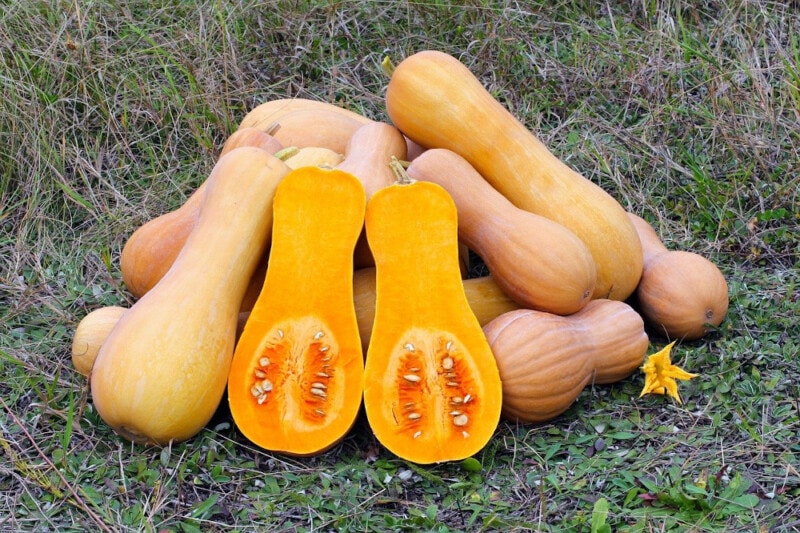
Squash can also be a good source of calcium. One of our favorites to cook with is butternut squash. This orange-fleshed gourd contains 84 milligrams of calcium (9% RDI) in every one-cup serving. Butternut squash is delicious when baked with a little vegan butter, and it can also be enjoyed as a seasonal soup.
Another bright orange veggie with a decent amount of calcium is the sweet potato.
Sweet potatoes contain around 4% of your calcium intake. And they can be enjoyed in a variety of ways, from sweet potato casserole to savory sweet potato fries.
Sesame Seeds
Many seeds contain a high amount of calcium per gram. And sesame contains the most.
In one tablespoon of these little seeds, you’ll get 9% of your RDI of calcium (88 mg). You can also reap the nutrient benefits of sesame in other forms, including tahini paste.
Other seeds high in calcium include chia (6% RDI per 1 tbsp) and sunflower (5% RDI per ½ cup).
Almonds

Not all nuts are high in calcium, but almonds do offer a decent amount. A typical serving (1 ounce) offers 8% of your RDI (97 milligrams). These nuts are also a good source of fiber, protein, and healthy fat.
Other nuts to include in your diet for a fair dose of calcium include:
- Brazil nuts – 5% RDI per 1 ounce
- Hazelnut – 3% RDI per 1 ounce
- Pistachio – 3% RDI per 1 ounce
Raw and cooked nuts make a filling snack. You can also add these calcium-rich nuts to your yogurt, oatmeal, and salads.
Okra

You either love okra or you hate it. If you’re in the category of the former, you’re in luck. Because okra is a good source of calcium. One cup of sliced okra contains 8% of your RDI (82 mg).
You can enjoy this odd, slimy vegetable by sauteing, pickling, roasting, or frying it. It also makes a great addition to veggie-heavy recipes like vegan gumbo and stews.
Vegan Calcium Supplements
There are plenty of great whole-food vegan sources of calcium out there. But if you feel like you’re having trouble meeting your daily needs, then it might be worth considering using a calcium supplement as well.
There are many great vegan calcium supplements on the market, including Future Kind, Global Healing, and HUM Nutrition. To learn more, check out our detailed recommendations for vegan calcium supplements.
How Much Calcium Do You Need?
How much calcium your body needs to build strong bones, maintain normal muscle and nerve function, and do all the other important tasks that involve this mineral, changes based on your age.
Teenagers, who are growing fast, need more calcium than the average adult. And aging women, especially those in menopause, suffer from lower bone density due to changes in estrogen. Getting adequate calcium before and during this time can help avoid osteoporosis.
Here is the RDI of calcium based on gender and age (source: NIH):
| Age | Male | Female |
| 4 to 8 | 1,000 mg | 1,000 mg |
| 9 to 13 | 1,300 mg | 1,300 mg |
| 14 to 18 | 1,300 mg | 1,300 mg |
| 19 to 50 | 1,000 mg | 1,000 mg |
| 51 to 70 | 1,000 mg | 1,200 mg |
| 71+ | 1,200 mg | 1,200 mg |
Plant-Based Calcium FAQ
It is a bit of a misnomer that vegans get less calcium than non-vegans. Yes, it’s true that oxalates in some veggies and phytic acids in legumes, seeds, and nuts can interfere with calcium absorption. But so can many of the compounds found in dairy.
The truth is, we don’t get to use all the calcium we consume no matter what form it takes. This is why it is important for everyone—vegan and otherwise—to consume plenty of healthy whole foods, including all those on the list above.
Many people are concerned about getting enough calcium each day to meet the higher needs that come with aging. Eating plenty of plant-based whole foods and fortified products, like orange juice and almond milk, will provide more than enough calcium for most people to meet their daily needs.
But if you’re worried about not getting enough, it can’t hurt to add a quality calcium supplement to your routine.
Dairy milk typically contains about 300 mg of calcium per 1 cup serving. This is on par with one cup of fortified almond milk or fortified orange juice, which also contain around 300 mg. Tofu, blackstrap molasses, dried figs, and white beans are also excellent sources of this mineral.
If you’re looking for more ways to add calcium to your diet, this comprehensive calcium content chart can help.
- How to Pick the Perfect Watermelon For a Sweet Summer Treat - April 10, 2024
- Future Kind’s Foundations: A Multivitamin Made for Vegans - December 5, 2023
- Does Nutritional Yeast Go Bad? - November 28, 2023


